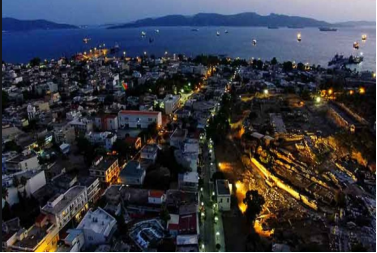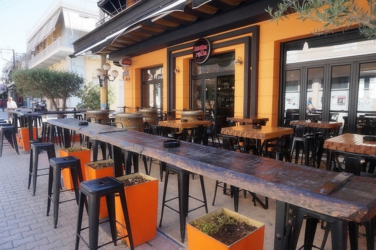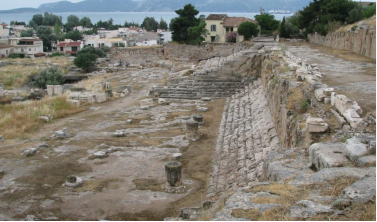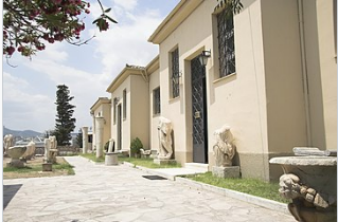Elefsina/Eleusis, West Attica, Attica 作者: 来源: 发布时间:2021-05-18
I. Population, Area
Total Area: 36.589 km2
Elevation: 5 m (16 ft)
Municipal unit density: 1,300 km2
Population: 29,902 (2011)

II.Natural Geography
Elefsina is renowned for its ancient history as well as for its more recent industrial development.
In ancient times it was one of the most important religious centres in Greece, retaining its sacred character over two thousand years and known across the world for the Eleusinian Mysteries.
The city of Eleusis, now known as Elefsina, a city between Athens and Corinth, was built around the sanctuary and temple of Demeter, the goddess of crops, which dated back to Mycenaean times. In the classical period the city was the site of the Eleusian Festival when thousands of pilgrims walked the sacred way from the Acropolis to be indoctrinated into the ancient mysteries. To divulge the secret of the Eleusinian Mysteries was punishable by death and for 1400 years these secrets were known only to the initiates. The site was the second most important in ancient Greece, after Delphi.
Elefsina currently suffers from poor road and pavement conditions, in addition, lack of public transport is contributing in the traffic congestion as residents need to use their cars daily. A large number of abandoned cars are left in the streets of the city which reduces the number of available parking spaces on public roads as well as weakens the general im- age of the city itself. Redundant railway lines built on raised ground divide the city in pieces and poor railway crossings prevent seamless transportation from happening throughout the city. Lack of consistent urban development and strategic ex- pansion of the city have led to a heavy industrial activity throughout the city, which replaces infrastructure from the list of priorities with industrial revenue.

III. ECONOMY
Immediately after the establishment of the Greek state, Eleusis was a small town of 250 people of Arvanitic origin. In the 1860s, the erection of new domestic complexes and the settlement of occasional traders gave a new look to the city. The 1880s were a crucial period for Eleusis, as it was then that industrial development was initiated and important industries were established. In 1922, 2,000 refugees from Asia Minor arrived at Eleusis, thus doubling its population. In 1943, the Community of Eleusis was recognised as a municipality. After World War II, internal migrants settled at Eleusis. During the 20th century, Eleusis was the centre of Greek industrial development with some of the largest factories of the country; there existed two refineries, two steel mills, two cement plants, two shipyards, an ammunition industry, and more than 2,000 smaller industries. In the 21st century, Eleusis is evolving into a centre of administrative and financial services and constitutes the seat of the Prefecture of Western Attica. Air and water pollution have been significantly reduced, as a result of the citizens’ systematic efforts, while cultural areas and recreation facilities have been established along the coast.
IV. Industrial Characterisitics
Elefsis Shipping Agency is a family-owned ship agency company based in Eleusis, Greece. In 2002, at Eleusis, driven by enthusiasm and love for shipping agency, founded Elefsis Shipping Agency by Costas Tselikas & Despoina Papaki. Elefsis Shipping Agency aims to provide the best Port Agency services to Ship owners/Operators and Charterers/Traders at Greek Ports.
RefeRences: https://www.elefshipagent.com/
V.Attractions
1.Archaeological Site and Museum of Eleusis

The Archeological Museum of Eleusis is a museum in Eleusis, Attica, Greece. The museum is located inside the archaeological site of Eleusis. Built in 1890, by the plans of the German architect Kaverau, to keep the findings of the excavations, and after two years (1892) was extended under the plans of the Greek architect J. Mousis.
There is a collection of objects dating from the 5th century BC, when the reputation of the temple was panhellenic, and the number of believers who moved there in order to attend the ceremonies of the Eleusinian mysteries had increased significantly.
Many of the findings are associated with these ceremonies. The Votive piglet reminds the sacrifice of these animals for the purgation of the believers at Phaleron, which took place in some of the preparatory stages of the ceremonies, and the kernos, a ceremonial vessel which was used at the sacrifices and at the offerings made to the altars and the temples, during the return of the sacred symbols through the Holy Road from the Ancient Agora back again to the Sanctuary for the final initiation.
The two most important findings of Eleusis have been transferred to the National Archaeological Museum of Athens and at the Museum of Eleusis exist only their copies. The first is the relief of the 5th century BC, height 2.20 m, showing Demeter, the Kore and the King of Eleusis Triptolemos, who is preparing to teach agriculture to the world, according to the instructions of the goddess. The second is the clay table known as the Ninnion Tablet with a gable, dedicated by Ninnion, from the 4th century BC, with scenes from the ceremonies at the temple of Demeter, which its significance consists in the information that provides on the strict secret rituals of the Eleusinian mysteries.
In addition, the museum houses a full collection of pottery, dating from Middle Helladic Era (2000 or 1950-1580 BC) to the early Christian times, written tables, metal items, inscriptions and reliefs, including the important votive relief of Rheitoi, with Demeter, the Kore, Athena and an Eleusinian man, which at the bottom has instructions for bridging the lake of Rheitoi (Koumoundourou lake).

The Archeological Museum of Eleusis is a museum in Eleusis, Attica, Greece. The museum is located inside the archaeological site of Eleusis. Built in 1890, by the plans of the German architect Kaverau, to keep the findings of the excavations, and after two years (1892) was extended under the plans of the Greek architect J. Mousis.
There is a collection of objects dating from the 5th century BC, when the reputation of the temple was panhellenic, and the number of believers who moved there in order to attend the ceremonies of the Eleusinian mysteries had increased significantly.
Many of the findings are associated with these ceremonies. The Votive piglet reminds the sacrifice of these animals for the purgation of the believers at Phaleron, which took place in some of the preparatory stages of the ceremonies, and the kernos, a ceremonial vessel which was used at the sacrifices and at the offerings made to the altars and the temples, during the return of the sacred symbols through the Holy Road from the Ancient Agora back again to the Sanctuary for the final initiation.
Among the most important exhibits of the museum are included: the monumental protoattic amphora from the middle of the 7th century BC, with the depiction of Medusa's beheading by Perseus, the famous "fleeing kore" from the archaic period, that probably comes from the architectural design of the Sacred House, the large headless statue of the goddess Demeter, probably the work of Agorakrito's school - a student of Pheidias-, and the Caryatid from the roof of the small Propylaea, bringing on her head the ciste, the container holding the sacred articles of the ceremony, with a relief appearance of the symbols of the Eleusinian cult, which are: the ear of grain, the poppies, the rozetes and the kernos.
The two most important findings of Eleusis have been transferred to the National Archaeological Museum of Athens and at the Museum of Eleusis exist only their copies. The first is the relief of the 5th century BC, height 2.20 m, showing Demeter, the Kore and the King of Eleusis Triptolemos, who is preparing to teach agriculture to the world, according to the instructions of the goddess. The second is the clay table known as the Ninnion Tablet with a gable, dedicated by Ninnion, from the 4th century BC, with scenes from the ceremonies at the temple of Demeter, which its significance consists in the information that provides on the strict secret rituals of the Eleusinian mysteries.
In addition, the museum houses a full collection of pottery, dating from Middle Helladic Era (2000 or 1950-1580 BC) to the early Christian times, written tables, metal items, inscriptions and reliefs, including the important votive relief of Rheitoi, with Demeter, the Kore, Athena and an Eleusinian man, which at the bottom has instructions for bridging the lake of Rheitoi (Koumoundourou lake).
VI. History
Eleusis was a deme of ancient Attica, belonging to the phyle Hippothoöntis. It owed its celebrity to its being the chief seat of the worship of Demeter and Persephone, and to the mysteries celebrated in honour of these goddesses, which were called the Eleusinia, and continued to be regarded as the most sacred of all the Grecian mysteries down to the fall of paganism.
Eleusis stood upon a height at a short distance from the sea, and opposite the island of Salamis. Its situation possessed three natural advantages. It was on the road from Athens to the Isthmus of Corinth; it was in a very fertile plain; and it was at the head of an extensive bay, formed on three sides by the coast of Attica, and shut in on the south by the island of Salamis. The town itself dates from the most ancient times.
According to Greek mythology Pluto, Lord of the Underworld, abducted Persephone, daughter of the goddess Demeter, and took her down into his kingdom with the intention to wed her. Demeter desperately looked for her for nine whole days until she finally arrived in Elefsina. Here she worked as a governess in the palace of King Keleos, but eventually, when her identity was discovered, she asked that a temple be built in the honour, where she locked herself up for a whole year mourning the loss of her daughter. During these twelve months not a single seed germinated. Much concerned, Zeus sent his messenger Hermes down to Pluto to see if the situation could be resolved. It was finally agreed that Persephone would stay half the year in the Underworld with her husband and the other half in the world above with her mother. When this compromse was reached Demeter allowed the earth to bear fruit again, and this is why even today cereals are known in Greek as demetriaka. The best cereal crops have always grown on the Thriasio Pedio - otherwise known as the Plain of Elefsina.
In 1829 after the Greek War of Independence, Eleusis was a small settlement of about 250 inhabitants. By the late 19th century Eleusis changed drastically as new buildings were erected by the new merchant settlers. Also during that period Eleusis became one of the main industrial centers of the Modern Greek State with concrete factory TITAN, Charilaou Soap Factory as well as the distilleries of Botrys and Kronos being established in the area.
Many Greek families of Asia Minor settled in Elefsina after the 1922 Asia Minor Catastrophe and created the settlement of Upper Elefsina, doubling its total population and enriching the region culturally and economically.
During the Axis occupation of Greece (1941–1945), strong resistance developed within the city, the factories and the military airport, which once stationed Squadron 80, the squadron that Roald Dahl was assigned to in the RAF. After World War II, workers from all parts of Greece moved to Elefsina to work in the industries in the region. Industrial activity, however, developed anarchically on the antiquities and next to the residential area.
Environmental pollution has taken on large dimensions. During the 20st century, at the time of sustainable development, archaeological discoveries and industrial formation shaped the image of contemporary Eleusis.
In 1962 a large house of priests from the Roman era was discovered. Pollution thanks to citizens' struggles gradually has fallen.
Today, the city has become a suburb of Athens, to which it is linked by the Motorway 6 and Greek National Road 8. Eleusina is nowadays a major industrial area, and the place where the majority of crude oil in Greece is imported and refined. The largest refinery is located on the west side of town, right beside where the annual Aeschylia Festival is held in honor of the great tragic poet Aeschylus.
References: https://www.elefsinahotel.gr/en/history-of-elefsina-city.html
VII. Other Information
On 11 November 2016 Eleusis was named the European Capital of Culture for 2021. The Monastery of Dafni, a recently restored monastery on the outskirts of Athens that was recently declared a UNESCO World Heritage Site.
Eleusis is home to the football club Panelefsiniakos F.C., and the basketball club Panelefsiniakos B.C.
VIII.Contact Information
Mayor:Argyris Oikonomou
Address:Hatzidakis & Dimitros, Elefsina
Tel: 15373, 210-5537100
Info: 210-55372
